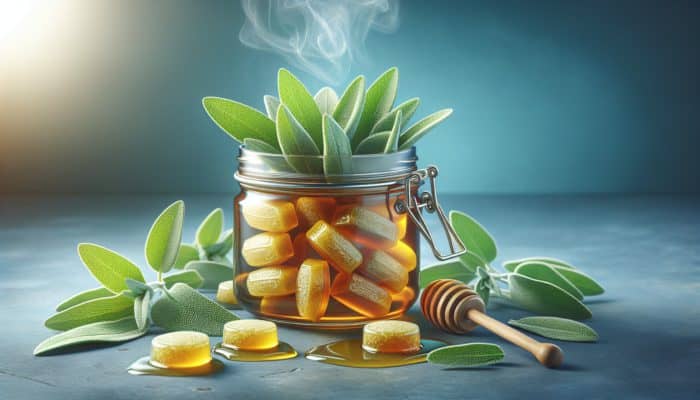Explore the Remarkable Healing Benefits of Sage for Sore Throat Relief
The extraordinary herb, sage, has been revered throughout history not only for its culinary applications but also for its significant medicinal properties. In the UK, where natural remedies are integral to traditional health practices, sage emerges as a formidable ally in mitigating throat discomfort. The three primary benefits of sage that enhance its efficacy in soothing sore throats include its anti-inflammatory properties, antimicrobial effects, and its capacity to provide immediate relief, establishing it as an essential component of any natural health toolkit.
Harnessing Sage’s Anti-Inflammatory Properties for Throat Relief

Inflammation often serves as the root cause of the irritation and discomfort linked to sore throats. Numerous studies underline that sage is abundant in powerful anti-inflammatory compounds, particularly rosmarinic acid. This specific compound functions by inhibiting the production of inflammatory cytokines, leading to a decrease in swelling and pain. Practically speaking, sipping <a href=”https://mcrtherapies.co.uk/techniques-for-herbal-steam-inhalation-a-guide-to-wellness/”>sage tea</a> is not only a comforting experience but also an effective method for alleviating throat inflammation and promoting overall throat health.
For individuals enduring chronic throat conditions, integrating sage into their dietary or wellness habits can significantly reduce symptoms, resulting in improved comfort and an enhanced quality of life. Furthermore, clinical studies have shown that sage can rival certain over-the-counter medications when it comes to reducing inflammation and providing pain relief. For those in the UK battling seasonal allergies, sage acts as a natural remedy, soothing the throat during flare-ups and offering a holistic approach to managing symptoms.
Moreover, when prepared correctly, sage tea can also function as a warm compress for the throat, further amplifying its anti-inflammatory benefits. The warmth from the tea encourages better blood circulation to the affected area, facilitating a more rapid recovery and increased comfort during episodes of throat discomfort.
Revealing the Antimicrobial Benefits of Sage for Throat Health
A sore throat frequently stems from bacterial or viral infections, making the antimicrobial properties of sage crucial in combating these harmful pathogens. Sage is renowned for its significant antimicrobial activity, thanks to its essential oils, which contain compounds such as thujone and camphor. Several studies have validated that these components effectively inhibit the growth of a wide range of bacteria and viruses that threaten throat health.
Research from the University of Reading has indicated that sage is particularly effective against common pathogens, including Streptococcus, the bacterium responsible for strep throat. By incorporating sage into one’s health regimen—especially during the cold and flu season—individuals can proactively prevent infections. In the UK, where the humid climate can exacerbate throat conditions, having sage readily available provides a natural defence against these seasonal challenges.
Furthermore, sage’s ability to inhibit microbial growth extends beyond immediate use in teas or gargles. It can also be formulated into lozenges or throat sprays, offering a convenient method to reap its benefits throughout the day. This versatility positions sage not merely as an herbal remedy but as a functional option for individuals seeking natural health solutions.
Experience Immediate Relief with Sage’s Soothing Qualities
One of the most immediate advantages of employing sage for sore throat relief is its inherently soothing properties. The experience of sipping warm sage tea can offer instant comfort, while the delightful flavour and aroma of the herb enhance overall enjoyment. Many users report a refreshing sensation that envelops them, replacing discomfort with a sense of tranquility. This calming effect arises from the herb's ability to relax the muscles in the throat, effectively diminishing the urge to cough.
In practical terms, preparing sage tea is a straightforward yet effective process. By steeping fresh or dried sage leaves in hot water, beneficial compounds are released, resulting in a warm infusion that can be savoured at leisure. This warmth is crucial in delivering the desired soothing relief, making sage tea a preferred remedy for anyone experiencing throat discomfort.
Beyond tea, gargling with a sage-infused solution can further amplify its soothing effects. When combined with salt—a common recommendation in UK health practices—this gargle can aid in cleansing and calming the throat, providing relief from irritation caused by persistent coughs and colds.
The cumulative benefits of sage—targeting inflammation, combating pathogens, and providing immediate comfort—position it as a prime choice for individuals seeking effective remedies for sore throat relief. In an age where many individuals are gravitating towards natural treatments, sage stands out as a potent option, firmly rooted in both tradition and scientific validation.
Effective Strategies to Enhance Sage’s Efficacy for Sore Throat Relief

Understanding how to effectively harness the advantages of sage for throat relief empowers individuals to manage their throat health efficiently. Several methods exist for utilising sage that can optimise its therapeutic potential, including preparing sage tea, creating a gargle solution, and using sage-infused lozenges. Each method offers unique benefits that contribute to a comprehensive wellness strategy.
Step-by-Step Guide to Brewing Sage Tea for Optimal Relief
The simplest yet most effective way to utilise sage for sore throat relief is by brewing sage tea. To prepare this soothing beverage, begin by boiling filtered water—if feasible, to ensure purity. Once the water reaches a rolling boil, add a handful of fresh sage leaves or two teaspoons of dried sage. Allow the mixture to steep for approximately ten minutes, a critical step that enables essential oils and beneficial compounds to infuse into the water, thereby enhancing the tea's health properties.
After brewing, strain the tea to remove the leaves and let it cool slightly before sipping. To enhance both flavour and medicinal benefits, consider adding honey, known for its soothing properties, which can effectively coat the throat. This combination not only promotes hydration but also ensures that the throat is enveloped in natural ingredients that work synergistically to provide relief.
Regular consumption of sage tea, particularly during colder months or whenever throat discomfort arises, can yield cumulative benefits. Many individuals in the UK have adopted this practice, often enjoying a cup in the evenings as a comforting ritual. The warmth of the tea can also promote relaxation, making it an ideal pre-bedtime drink.
For those with busy lifestyles, sage tea can be brewed in larger quantities and stored in the refrigerator for future use. Simply reheat as needed for an instant burst of throat support, ensuring you are always prepared to address any potential throat issues.
Creating a Sage Gargle Solution for Targeted Throat Relief
A sage gargle solution provides a focused approach to alleviating sore throat irritation. To create this solution, start with a cup of freshly brewed sage tea, following the preparation method previously outlined. Once your tea has cooled to a lukewarm temperature, add a teaspoon of salt. Salt acts as a natural antiseptic, enhancing the gargle's effectiveness in alleviating throat swelling and discomfort.
When gargling with this solution, take a small sip, tilt your head back, and gently gargle for about 30 seconds before spitting it out. This practice can be repeated several times throughout the day, particularly after meals or before bedtime. The combination of sage and salt works to combat bacteria present in the throat while also providing a calming effect.
Research indicates that individuals who regularly use saltwater gargles experience reduced throat discomfort, and the addition of sage can amplify these positive effects. Those in the UK, particularly during winter months when throat infections are prevalent, may find this method especially beneficial.
For enhanced effectiveness, consider adding other soothing ingredients to your gargle solution, such as apple cider vinegar, which can further boost health benefits and enhance the antimicrobial properties of sage.
Experience the Convenience of Sage Lozenges for On-the-Go Throat Relief

For those seeking a portable solution to sore throat discomfort, sage-infused lozenges present an excellent alternative. These lozenges typically blend the beneficial properties of sage with soothing agents such as honey, menthol, or lemon. They provide convenient on-the-go relief, particularly in situations when drinking tea or gargling may not be practical.
When selecting sage lozenges, opt for options that feature natural ingredients, avoiding products laden with artificial flavours or sweeteners. Numerous health food stores across the UK offer a variety of sage lozenges, often in organic formulations that ensure you receive the full benefits of the herb without unnecessary additives.
For maximum effectiveness, follow the instructions on the packaging, typically allowing them to dissolve slowly in the mouth. This process enables the active ingredients to coat the throat, providing a soothing effect that lasts longer than the immediate relief afforded by tea or gargles.
Incorporating sage lozenges into a comprehensive throat care strategy can be particularly advantageous for individuals who frequently speak or sing, such as teachers and performers. These lozenges can help maintain throat hydration and comfort throughout the day, making it easier to meet vocal demands without discomfort.
Exploring the Different Varieties of Sage Available in the UK
In the UK, several types of sage are readily accessible, each offering unique benefits that enhance the effectiveness of sage in soothing sore throats. Understanding these varieties can assist individuals in selecting the most suitable sage for their specific needs.
Common Sage: The Most Popular Variety
The most recognised variety is Common Sage, scientifically known as Salvia officinalis. This sage is easily found in supermarkets and health food stores throughout the UK, making it a convenient choice for those seeking natural remedies. Renowned for its robust flavour and numerous health benefits, Common Sage is a staple in both culinary dishes and herbal remedies.
The leaves of Common Sage are abundant in essential oils and antioxidants, making them an excellent choice for combating inflammation. Its uses extend beyond mere sore throat relief; this variety is frequently incorporated into cooking, allowing individuals to benefit from its properties while enjoying delicious meals. Regularly adding Common Sage to dishes can significantly enhance overall throat health.
Furthermore, many gardeners in the UK cultivate Common Sage in their herb gardens, appreciating its ease of growth and resilience. Its hardy nature allows it to thrive in various climates, ensuring a fresh supply for those who prefer to use it in its raw form.
Pineapple Sage: A Unique and Aromatic Option
Another noteworthy variety is Pineapple Sage, scientifically named Salvia elegans. Although less common than its counterpart, Pineapple Sage is cherished for its aromatic leaves that emit a sweet, fruity fragrance reminiscent of pineapple. This variety is often employed in herbal remedies and offers a novel twist to traditional sage applications.
While Pineapple Sage may not be as widely recognised for its sore throat benefits, it possesses similar properties to Common Sage. Users have reported positive effects when using Pineapple Sage in teas or infusions. Its refreshing taste can make it a delightful alternative for those seeking a sweeter approach to their throat relief regimen.
Though Pineapple Sage may be less accessible than Common Sage, it can often be found in specialty herbal shops and select online retailers across the UK. For those who enjoy experimenting with flavours in their remedies, Pineapple Sage provides a creative avenue for soothing sore throats.
Clary Sage: Complementary Properties for Overall Relaxation
Clary Sage, or Salvia sclarea, is another variety found in the UK, often recognised for its distinct aroma and applications in aromatherapy. While Clary Sage is not as commonly utilised for sore throat relief, it possesses several properties that can complement traditional sage methods.
Clary Sage is well-known for its calming effects, making it an ideal addition to relaxation rituals, especially for those who experience throat discomfort exacerbated by stress. When combined with traditional remedies like teas or lozenges, Clary Sage can enhance the overall soothing experience, creating a multifaceted approach to throat health.
Users interested in the holistic aspects of Clary Sage may also explore its uses in essential oil form, which can be diffused or applied topically (when appropriately diluted). This variety's versatility allows it to be integrated into both herbal and aromatic remedies, offering diverse pathways for relief.
Finding High-Quality Sage in the UK
Locating high-quality sage in the UK is relatively straightforward, given its popularity in both culinary and medicinal contexts. Whether you’re in search of fresh leaves, dried herbs, or sage-infused products, a variety of sources are available to cater to your needs.
Local Supermarkets: Your Convenient Source for Sage
Most UK supermarkets carry a range of fresh and dried herbs, including sage. Stores such as Tesco, Sainsbury’s, and Waitrose typically feature dedicated herb sections, making it easy to locate Common Sage for your home remedies. Fresh sage is often found in the produce section, while dried sage can usually be located in the baking or spice aisle.
When purchasing sage from supermarkets, look for vibrant, green leaves when buying fresh. Dried sage should be aromatic and not overly dusty or faded. Always check the packaging for expiration dates to ensure you are purchasing the freshest ingredients available.
Many supermarkets also offer organic options, which can enhance the health benefits of sage. Opting for organic sage ensures fewer chemical residues and may result in a more potent flavour and aroma.
Health Food Stores: A Treasure Trove of Sage Varieties
Specialty health food stores in the UK often provide a broader variety of sage products than mainstream supermarkets. Outlets such as Holland & Barrett and independent herbal shops frequently carry fresh, dried, and powdered sage, as well as sage-infused offerings, including teas and lozenges.
Shopping at health food stores allows customers to explore various sage varieties, including Pineapple Sage and Clary Sage, which may not be readily available in regular supermarkets. The staff at these stores are often knowledgeable about herbal remedies and can offer valuable insights on which sage products are best suited to specific health needs.
Additionally, health food stores typically prioritise organic and sustainably sourced products, ensuring that customers receive high-quality ingredients. This focus on natural health can be a notable advantage for individuals looking to incorporate sage into their wellness routines.
Online Retailers: The Convenience of Digital Shopping for Sage
For those who prefer the ease of online shopping, numerous UK retailers provide sage in various forms. Websites such as Amazon, eBay, and dedicated herb shops offer a comprehensive selection of sage, including dried leaves, teas, tinctures, and lozenges.
When purchasing sage online, it is essential to thoroughly read product descriptions to ensure quality and origin. Checking reviews and ratings can also help gauge the reliability of the seller and the effectiveness of their sage products.
Online shopping also enables consumers to easily compare prices and discover brands that may not be available in local stores. For those residing in rural areas or locations with limited access to herbal remedies, online retailers can be a vital resource for obtaining high-quality sage products.
Understanding the Safety and Precautions Associated with Sage Usage
While sage offers numerous benefits for sore throat relief, it is crucial to approach its use with knowledge and caution. Recognising potential allergies, adhering to dosage guidelines, and consulting healthcare providers ensures that individuals can safely enjoy the therapeutic effects of sage without adverse reactions.
Identifying and Managing Potential Allergic Reactions to Sage
As with any herbal remedy, some individuals may experience allergic reactions to sage. Symptoms can range from mild irritation to more severe reactions, including skin rashes or gastrointestinal discomfort. It is advisable to conduct a patch test before consuming sage in larger quantities, especially for those with a history of allergies to herbs.
Starting with modest doses, such as a cup of sage tea, allows individuals to monitor their body's responses. If any adverse reactions occur, it is critical to discontinue use immediately and consult a healthcare professional.
For those with known allergies to plants in the Lamiaceae family (which includes mint and basil), caution is advised when using sage. Always consult a healthcare provider if you have any doubts about potential allergic reactions.
Adhering to Recommended Dosage Guidelines for Sage
When utilising sage for medicinal purposes, it is vital to follow recommended dosage guidelines to avoid potential side effects from overuse. While sage tea is generally safe for most individuals when consumed in moderation, excessive intake can lead to gastrointestinal issues or other unwanted effects.
For sage tea, one to three cups per day is typically regarded as safe for adults. If using sage in concentrated forms, such as essential oils or extracts, it is essential to follow the manufacturer's guidelines or directions provided by a healthcare provider.
Pregnant or breastfeeding women should exercise caution and consult a healthcare professional before using sage in significant amounts, as certain compounds present in sage may not be safe during pregnancy.
The Importance of Consulting Healthcare Providers Before Using Sage
Engaging with a healthcare provider before starting any new herbal regimen is always a sensible choice. This is particularly true for individuals taking medications or those with pre-existing health conditions. Sage may interact with certain medications, including blood thinners and antidiabetic drugs, potentially altering their effects.
A healthcare provider can offer personalised advice based on individual health needs, ensuring that the use of sage aligns with overall wellness plans. This proactive approach enables individuals to benefit from sage's properties while minimising potential risks associated with its use.
Proper Storage and Handling Techniques for Sage
To maintain the potency and effectiveness of sage, proper storage and handling are essential. Fresh sage should be stored in the refrigerator, wrapped in a damp paper towel or placed in a sealed container to preserve its moisture and freshness. Dried sage should be kept in a cool, dry place, ideally in an airtight container, to prevent exposure to light and moisture that can degrade its quality.
When handling sage, always ensure that your hands and utensils are clean to avoid contamination. This practice not only preserves the integrity of the herb but also enhances its health benefits.
By adhering to these safety and precautionary measures, individuals can safely integrate sage into their routines, maximising its potential for soothing sore throat relief.
Enhancing Sage's Effectiveness by Combining it with Other Natural Remedies
To amplify the soothing effects of sage for sore throat relief, consider blending it with other natural ingredients. Incorporating elements such as honey, lemon, ginger, echinacea, and peppermint can enhance the therapeutic properties of sage, providing a multifaceted approach to throat health tailored to diverse needs.
Enhancing Sage’s Benefits with Honey for Throat Comfort
The combination of honey and sage creates a delicious and effective remedy. Honey possesses natural antibacterial and anti-inflammatory properties, making it an ideal companion for sage. Mixing sage tea with a teaspoon of honey not only improves the flavour but also adds additional soothing benefits for the throat.
Research suggests that honey can be as effective as some over-the-counter cough medications, particularly for children. By incorporating honey into sage tea, individuals can create a soothing drink that alleviates both throat irritation and coughing.
For added benefit, consider using raw or local honey, which may contain additional enzymes and nutrients that enhance its therapeutic properties. This combination is particularly popular in the UK, where both honey and sage are readily available, making it an uncomplicated remedy to prepare.
The Refreshing Duo of Lemon and Sage
Adding lemon juice to sage tea can significantly enhance its antimicrobial effects. Lemon is rich in vitamin C, which supports immune function and can help combat infections. The tartness of lemon beautifully complements the flavour of sage, creating a refreshing beverage that is both tasty and beneficial.
The synergy between sage and lemon can be especially advantageous during colder months when throat infections are more prevalent. By regularly consuming this blend, individuals may not only soothe their sore throats but also strengthen their immune systems, making them more resilient against viral and bacterial infections.
For an enticing twist, consider infusing sage and lemon into hot water, allowing the two flavours to meld harmoniously. This simple yet effective remedy is ideal for those seeking a natural solution to address throat discomfort.
The Powerful Combination of Ginger and Sage
Combining sage with ginger offers an additional layer of anti-inflammatory benefits. Ginger is well-known for its ability to reduce inflammation and soothe gastrointestinal discomfort. When used alongside sage, these two herbs can provide comprehensive support for throat health and overall wellness.
To create a ginger-sage tea, add fresh ginger slices to your sage tea preparation. Allow the mixture to steep, enabling the flavours and beneficial compounds to infuse into the water. This combination is particularly beneficial for individuals experiencing both throat pain and digestive issues, promoting relief on multiple fronts.
In the UK, ginger is widely available and can be found in both fresh and dried forms. Incorporating ginger into sage remedies can create a warming beverage that not only alleviates sore throat symptoms but also provides digestive comfort during the colder months.
Boosting Immunity with Echinacea and Sage
The immune-boosting properties of echinacea make it a compelling partner for sage. Echinacea has long been utilised to support the immune system and may help reduce the duration and severity of colds and infections. When combined with sage, this duo can create a powerful remedy for those battling sore throats.
To utilise this combination, consider brewing an echinacea-sage tea. By brewing both herbs together, their beneficial compounds can synergise for maximum effectiveness. Regular consumption during cold and flu season can fortify your body’s defences against common illnesses.
Echinacea is available in various forms, including dried herbs, capsules, and tinctures. Always follow dosage recommendations for echinacea to ensure safe and effective use, especially when combining it with sage.
The Refreshing Blend of Peppermint and Sage
Incorporating peppermint into sage tea not only enhances the flavour but also provides additional digestive benefits. Peppermint is celebrated for its soothing effects on the gastrointestinal tract, making this combination a well-rounded remedy for individuals experiencing both sore throats and digestive issues.
To prepare peppermint-sage tea, add fresh or dried peppermint leaves to your sage tea mixture. The resulting beverage is refreshing and can be enjoyed hot or iced, depending on personal preference and the desired effect.
In the UK, peppermint is readily available in both fresh and dried forms. This combination serves as an excellent remedy, particularly for those who often experience throat discomfort alongside digestive upset, offering a comforting solution for multiple issues.
By combining sage with these other beneficial ingredients, individuals can develop versatile and effective remedies for sore throat relief. Each combination brings unique strengths, allowing for a personalised approach to throat health that meets individual needs and preferences.
Frequently Asked Questions About Sage and Its Applications
What are the primary uses of sage?
Sage is utilised for various purposes, including culinary applications and natural remedies. It is well-known for its anti-inflammatory and antimicrobial properties, making it a popular choice for soothing sore throats and addressing digestive issues.
How does sage alleviate sore throats?
Sage contains anti-inflammatory compounds that help reduce throat swelling, while its antimicrobial properties assist in combating infections. Drinking sage tea or using it in gargles can provide soothing relief from throat discomfort and irritation.
Is it safe to consume sage tea daily?
Yes, drinking sage tea daily is generally safe for most individuals. However, moderation is key; one to three cups per day is recommended. It's always best to consult a healthcare provider if you have concerns about daily consumption.
Can sage be safely consumed during pregnancy?
Sage should be used cautiously during pregnancy. High doses of sage may pose risks, so consulting a healthcare provider before incorporating it into your routine is essential.
Can I use dried sage to make tea?
Absolutely! Dried sage can be used to prepare tea just as effectively as fresh sage. Ensure it is stored properly to maintain its potency and health benefits.
What potential side effects can occur from consuming sage?
While sage is generally safe, excessive consumption can lead to side effects, such as gastrointestinal upset or allergic reactions. It is advisable to start with small amounts to monitor your body's response before increasing the dosage.
How can I create a sage gargle solution?
To prepare a sage gargle, brew sage tea, allow it to cool slightly, and mix in a teaspoon of salt. Gargle with this solution to effectively soothe throat irritation.
Is sage suitable for children with sore throats?
Sage can be used for children, but it is vital to consult a healthcare provider first. Ensure that any remedies are appropriately dosed based on the child's age and weight to guarantee safety.
Where can I purchase sage in the UK?
Sage can be found in local supermarkets, health food stores, and online retailers throughout the UK. Look for fresh, dried, or sage-infused products according to your needs and preferences.
Does sage interact with any medications?
Yes, sage may interact with certain medications, including blood thinners and antidiabetic drugs. Always consult a healthcare provider before using sage if you are taking any medications to avoid potential complications.
Connect with us on Facebook!
The Article: Sage for Sore Throat Relief: Natural Remedies appeared first on https://mcrtherapies.co.uk
The Article Sore Throat Relief: Natural Remedies with Sage Was Found On https://limitsofstrategy.com

